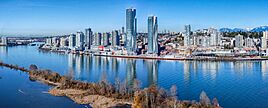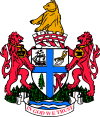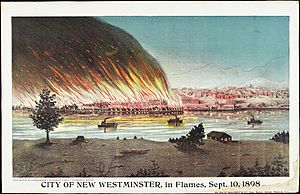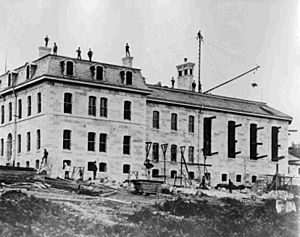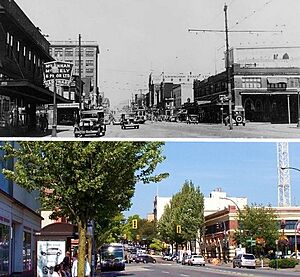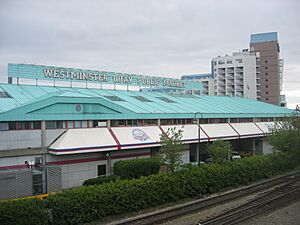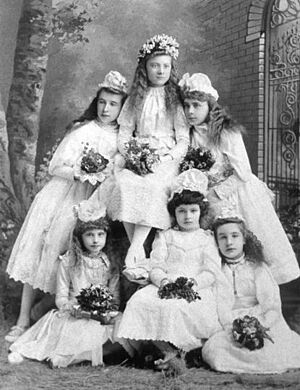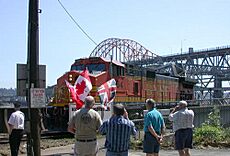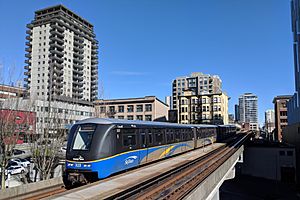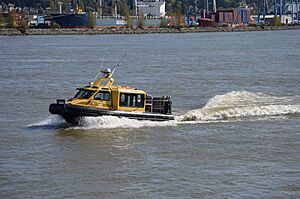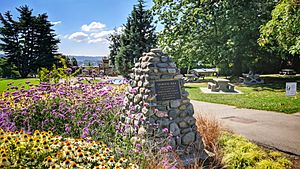New Westminster facts for kids
Quick facts for kids
New Westminster
|
|||||
|---|---|---|---|---|---|
|
City
|
|||||
| The City of New Westminster | |||||
|
From top, left to right: New Westminster skyline; Expo Line; Queens Park; New Westminster pier; New Westminster Court House; the SkyBridge, a cable-stayed bridge located over the Fraser River between New Westminster and Surrey; Poplar Island and Fraser River
|
|||||
|
|||||
| Nickname(s):
"New West"
|
|||||
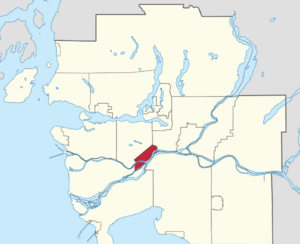
Location of New Westminster in Metro Vancouver
|
|||||
| Country | Canada | ||||
| Province | British Columbia | ||||
| Regional district | Metro Vancouver | ||||
| Founded | 1858 | ||||
| Renamed | July 20, 1859 | ||||
| Incorporated | July 16, 1860 | ||||
| Founded by | Richard Moody | ||||
| Named for | City of Westminster | ||||
| Government | |||||
| • Type | Mayor-council government | ||||
| • Body | New Westminster City Council | ||||
| Area | |||||
| • Land | 15.62 km2 (6.03 sq mi) | ||||
| Elevation | 60 m (200 ft) | ||||
| Population
(2021)
|
|||||
| • Total | 78,916 | ||||
| • Estimate
(2023)
|
88,945 | ||||
| • Density | 5,052.4/km2 (13,086/sq mi) | ||||
| • Private Dwellings | 37,737 | ||||
| Time zone | UTC−08:00 (PST) | ||||
| • Summer (DST) | UTC−07:00 (PDT) | ||||
| Forward sortation area |
V3L – V3M
|
||||
| Area codes | 604, 778, 236, 672 | ||||
New Westminster (often called New West) is a city in the Lower Mainland area of British Columbia, Canada. It is part of the Metro Vancouver Regional District. The city was started by Major-General Richard Moody in 1858. It was the first capital of the Colony of British Columbia until 1866. New Westminster was the largest city on the BC Mainland until Vancouver grew bigger in the early 1900s.
The city is located on the banks of the Fraser River. This is where the river turns southwest towards the ocean. New Westminster is on the southwest side of the Burrard Peninsula. It is also near the center of the Greater Vancouver region.
Contents
- History of New Westminster
- Geography of New Westminster
- Population and People
- Media in New Westminster
- Arts and Culture in New Westminster
- New Westminster's Heritage
- Education in New Westminster
- Transportation in New Westminster
- Sports and Recreation in New Westminster
- Famous People from New Westminster
- International Connections
- Images for kids
- See also
History of New Westminster

The land where New Westminster is now was first home to the Kwantlen First Nation. In the mid-1800s, gold was discovered in British Columbia. Many gold seekers came from the south. This made settlers worried that Americans might try to take over the land.
Founding the Royal City
Richard Clement Moody arrived in British Columbia in December 1858. He led the Royal Engineers, Columbia Detachment. Moody was chosen to "found a second England on the shores of the Pacific." He wanted to build a beautiful city in the wilderness. He planned it to show British power.
Moody and the Royal Engineers chose the location carefully. It was easy to defend and had good water access. It also had a great port. Moody was impressed by the beauty of the area. He described the Fraser River entrance as "striking" with "Superb Mountains." He imagined rich meadows with cattle.
In February 1859, Governor James Douglas named the new capital "Queensborough." However, Queen Victoria in London did not like this name. She named the city after Westminster, a famous part of London where the Parliament Buildings are. Because the Queen named it, New Westminster earned its nickname, "the Royal City."
A year later, in 1860, New Westminster became the first city in British Columbia to have its own elected government. It became a key stop for gold prospectors. They traveled by steamboat or canoe up the Fraser River to reach goldfield towns like Yale.
Challenges and Changes
The British government did not provide enough money to develop the city. This made it hard for Moody's plans to be fully carried out. Governor Douglas did not spend much time in New Westminster. He preferred to stay in Victoria. The people of New Westminster supported Colonel Moody and were unhappy with the governor.
New Westminster's early citizens were mostly Canadians. They focused on business. They were upset when Victoria was made a free port, which hurt New Westminster's economy. Also, Governor Douglas added taxes on goods coming into New Westminster to pay for roads.
In 1866, the Colony of British Columbia and the Colony of Vancouver Island joined together. Victoria became the capital of the new combined colony. This decision was made after a vote in the assembly. Some say the vote was unfair, with one member messing up another's speech and glasses! The vote was 13 to 8 against New Westminster.
When British Columbia joined Canada in 1871, New Westminster's economy got better. But the city faced another challenge when the Canadian Pacific Railway chose Vancouver as its main stop. Even though a railway line reached New Westminster in 1886, Vancouver grew much faster.
In 1898, a large fire destroyed much of downtown New Westminster. In 1916, the government closed off areas used by Coastal First Nations people during fishing season. These lands were then given to the BC government.
From 1927 to 1969, scientists collected daily water temperature and saltiness data from New Westminster. This helped the Department of Fisheries and Oceans.
In 1991, the New Westminster Armoury was recognized as an important heritage building. In 2020, New Westminster had very bad air quality. This was due to smoke from wildfires and a fire at the old pier.
In 2022, the city started looking into changing its "Royal City" nickname. They also considered rebranding the city's logo and mottos.
Geography of New Westminster
New Westminster is on the Burrard Peninsula, mostly on the north side of the Fraser River. It is about 19 kilometers (12 miles) southeast of Vancouver. It is next to Burnaby and Coquitlam. Across the Fraser River are Surrey and Delta. A part of New Westminster called Queensborough is on the eastern tip of Lulu Island. This area is next to Richmond. The city covers a total land area of 15.62 square kilometers (6.03 square miles).
Exploring New Westminster's Neighborhoods
New Westminster has changed a lot over time. It has become part of the larger urban area of the Lower Mainland.
BC Penitentiary
In 1878, the first federal prison west of Manitoba opened in New Westminster. It was called the British Columbia Penitentiary, or "BC Pen." It was located between the Sapperton neighborhood and Queen's Park. This prison held serious offenders for 102 years, closing in 1980. The original main building still stands and is now used as offices. The old Gatehouse and Coal House are also still there. The rest of the prison land now has new homes and parks.
Woodlands
Woodlands was a hospital for children with mental health needs. It was located west of the BC Pen. After it closed, the main building was mostly destroyed by fire in 2008. By 2011, all the old structures were removed.
Chinatown
New Westminster had one of the first Chinatowns on the mainland of British Columbia. At first, it was the second largest after Victoria's Chinatown. Before Vancouver's Chinatown grew, New Westminster's was the biggest on the mainland.
The original Chinatown was on Front Street. A second Chinatown opened in an area called "The Swamp." This area was low, wet ground near the river and railway. It was destroyed in the Great Fire of 1898. Only a church and a community hall were rebuilt there.
Columbia Street
Until 1964, Columbia Street was the main shopping area for the Fraser Valley. It was known as "the golden mile." Big department stores like Eaton's and Woolworths were there. Even people from Vancouver would travel to shop on Columbia Street. The street also had large movie theaters.
However, a new freeway and suburban malls with free parking hurt Columbia Street. Many stores left. In 2006, Columbia Street was rebuilt to have one lane in each direction and a bike lane. This was done to encourage more walking and biking. Many new buildings and renovations have happened since then. The Columbia Theatre is now a cabaret-style venue. A new park, Westminster Pier Park, opened in 2012.
Connaught Heights
Connaught Heights is the westernmost neighborhood in New Westminster. It started as District Lot 172. In 1911, the land was divided into housing lots. In 1912, the BC Electric Railway built the "Connaught Hill" station there. This station connected New Westminster with Vancouver. The station was named after Prince Arthur, Duke of Connaught and Strathearn.
At first, the area did not have many services. But as more people moved in, things improved. In 1939, water and electricity services were upgraded. In 1964, Connaught Heights officially became part of New Westminster.
Front Street
Front Street was once a busy dockside street and market. It also had the original Chinatown. In the 1960s, it was changed into a truck route and an elevated parking garage. In recent years, it has become known for antique and second-hand shops.
Front Street has also been used as a filming location for movies. These include Rumble in the Bronx and I, Robot. In 2016, part of the parking garage was taken down. This was part of the city's plan to improve its waterfront area.
New Westminster Canadian Pacific Railway Station
A former Canadian Pacific Railway station is next to the New Westminster Skytrain station. It is a two-story red brick building with steep roofs. Built in 1899, it is a classic example of CPR's Château-style stations. In 1973, the old train station became a restaurant. In 2013, the restaurant closed due to structural problems. As of 2023, another restaurant chain, Kelly O'Bryan's, is in the building.
Queensborough
Queensborough was the first name chosen for the colonial capital by Colonel Richard Clement Moody. But Queen Victoria chose New Westminster instead. So, the name Queensborough was given to New Westminster's part of Lulu Island. This area is across the Fraser River from the main city. Today, Queensborough is a growing area with its own unique feel.
Sapperton
Sapperton was originally a "suburb" of New Westminster. It was named after the Royal Engineers ("Sappers"). Their camp was on the hill where the Fraserview neighborhood is now. Sapperton is home to the historic Fraser Cemetery. This cemetery has many important historical graves.
Sapperton also had the first commercial brewery in British Columbia, called the "City Brewery." It later became Labatts. The brewery closed in 2005. Now, a condo development called the "Brewery District" is there. New Westminster now has two breweries: Steel & Oak (opened 2014) and Another Beer Co (opened 2019). The Royal Columbian Hospital is also in Sapperton.
Uptown "6th and 6th"
An uptown shopping area started to grow around 6th Street and 6th Avenue in 1954. This was when the Woodward's department store opened. The public library also moved uptown in 1958. In 1992, Woodward's became a shopping center called Woodwards Place. After Woodward's went out of business in 1993, the center was renamed Royal City Centre Mall. Moody Park is a large park in the uptown area.
West End
New Westminster's West End was once quite separate from the main city. It has a small shopping area along 12th Street and 20th Street. The 12th Street area is known for antique and unique stores.
Westminster Quay
Westminster Quay was developed in the mid-1980s to make New Westminster more lively. This happened when the SkyTrain line to Vancouver was built. It included a large public market and a hotel. Many apartments and townhouses were also built.
Over time, the commercial part of the Quay became less busy. In 2010, the market reopened as The River Market. It has Donald's Market as its main store. The Westminster Quay is also home to a 9.75-meter (32-foot) tall tin soldier. In 2002, this soldier was named the world's largest by Guinness World Records.
Population and People
| Historical populations | ||
|---|---|---|
| Year | Pop. | ±% |
| 1921 | 14,495 | — |
| 1931 | 17,524 | +20.9% |
| 1941 | 21,967 | +25.4% |
| 1951 | 28,639 | +30.4% |
| 1956 | 31,665 | +10.6% |
| 1961 | 33,654 | +6.3% |
| 1966 | 38,013 | +13.0% |
| 1971 | 42,835 | +12.7% |
| 1976 | 38,393 | −10.4% |
| 1981 | 38,550 | +0.4% |
| 1986 | 39,972 | +3.7% |
| 1991 | 43,585 | +9.0% |
| 1996 | 49,350 | +13.2% |
| 2001 | 54,656 | +10.8% |
| 2006 | 58,549 | +7.1% |
| 2011 | 65,976 | +12.7% |
| 2016 | 70,996 | +7.6% |
| 2021 | 78,916 | +11.2% |
| Source: Statistics Canada | ||
In the 2021 Canadian census, New Westminster had a population of 78,916 people. This was a 11.2% increase from 2016. With a land area of 15.62 square kilometers, the city had a population density of 5,052.4 people per square kilometer in 2021. New Westminster has the second highest population density of any Canadian city, after Vancouver.
Different Cultures and Languages
The Queensborough neighborhood has a large South Asian population. Many of them are Punjabi Sikh.
| Panethnic group | 2021 | 2016 | 2011 | 2006 | 2001 | |||||
|---|---|---|---|---|---|---|---|---|---|---|
| Pop. | % | Pop. | % | Pop. | % | Pop. | % | Pop. | % | |
| European | 39,080 | 50.07% | 40,400 | 57.79% | 40,225 | 61.8% | 38,920 | 67.28% | 38,805 | 72.11% |
| East Asian | 11,075 | 14.19% | 9,465 | 13.54% | 7,475 | 11.48% | 5,270 | 9.11% | 3,850 | 7.15% |
| South Asian | 8,105 | 10.38% | 5,790 | 8.28% | 5,500 | 8.45% | 4,660 | 8.06% | 4,220 | 7.84% |
| Southeast Asian | 8,065 | 10.33% | 6,550 | 9.37% | 5,415 | 8.32% | 3,680 | 6.36% | 2,795 | 5.19% |
| African | 2,695 | 3.45% | 1,740 | 2.49% | 1,155 | 1.77% | 1,370 | 2.37% | 1,120 | 2.08% |
| Latin American | 2,560 | 3.28% | 1,275 | 1.82% | 1,155 | 1.77% | 815 | 1.41% | 350 | 0.65% |
| Indigenous | 2,425 | 3.11% | 2,295 | 3.28% | 2,240 | 3.44% | 1,835 | 3.17% | 1,590 | 2.95% |
| Middle Eastern | 1,775 | 2.27% | 1,300 | 1.86% | 1,315 | 2.02% | 890 | 1.54% | 680 | 1.26% |
| Other/multiracial | 2,275 | 2.91% | 1,085 | 1.55% | 610 | 0.94% | 405 | 0.7% | 400 | 0.74% |
| Total responses | 78,055 | 98.91% | 69,905 | 98.46% | 65,090 | 98.66% | 57,850 | 98.81% | 53,810 | 98.45% |
| Total population | 78,916 | 100% | 70,996 | 100% | 65,976 | 100% | 58,549 | 100% | 54,656 | 100% |
| Note: Totals greater than 100% due to multiple origin responses. | ||||||||||
The 2016 census showed that English was the first language for about 50.47% of the people. Other common first languages were Tagalog (4.5%), Mandarin (4.4%), and Punjabi (3.5%).
| Rank | Mother tongue | Population | Percentage |
|---|---|---|---|
| 1 | English | 42,925 | 63.1% |
| 2 | Tagalog | 3,075 | 4.5% |
| 3 | Mandarin | 3,015 | 4.4% |
| 4 | Punjabi | 2,410 | 3.5% |
| 5 | Cantonese | 2,105 | 3.1% |
| 6 | Spanish | 1,265 | 1.9% |
| 7 | Korean | 1,245 | 1.8% |
| 8 | Russian | 1,035 | 1.5% |
| 9 | French | 790 | 1.2% |
| 10 | Romanian | 740 | 1.1% |
Religion in New Westminster
According to the 2021 Canadian census, the main religious groups in New Westminster were:
- People with no religion (46.9%)
- Christianity (38.9%)
- Sikhism (4.8%)
- Islam (3.4%)
- Hinduism (2.6%)
- Buddhism (1.9%)
- Judaism (0.3%)
Media in New Westminster
The Columbian was British Columbia's second newspaper. It was started in New Westminster by John Robson. The newspaper published its last issue in 1983, after 123 years.
CKNW is one of Canada's first private news radio stations. It began broadcasting from New Westminster in 1944. Even though it has broadcast from Vancouver for many years, it is still officially licensed to New Westminster. Its callsign "NW" stands for New Westminster.
Today, New Westminster has two main publications. The New Westminster Record publishes news online. In 2022, New West Anchor was launched. It is a biweekly newsletter that shares news and events.
Arts and Culture in New Westminster
New Westminster has several places for live performances. These include the Massey Theatre and the Burr Theatre. The Burr Theatre was once a cinema. It is now a cabaret-style theater and home to Lafflines Comedy Club. Queens Park has two other theater venues. The Royal City Musical Theatre performs at the Massey Theatre.
Douglas College offers training in theater, stagecraft, and music. They also have music courses for all ages. Theater shows and music concerts are held at the Laura C. Muir Performing Arts Theatre. Each year, New Westminster hosts the New West Cultural Crawl. This event shows off the city's talented artists. The Mushtari Begum Festival of Indian Classical Music and Dance also takes place here.
New Westminster's Heritage
The New Westminster Museum and Archives (NWMA) features the Irving House. This house, built in 1865, is believed to be the oldest house still standing in the BC Lower Mainland. The museum also has historical items like an 1876 coach. The city's archives keep old maps and official records.
Other historical items in the city include the 1937 Samson V paddlewheeler. There are also 1890s armouries, 1850s cannons, and many heritage homes. Many of these homes date back to the 1800s.
Hyack Festival and Anvil Battery

New Westminster's May Day celebration started in 1870. It is still an important tradition today. This makes it the longest-running May Day celebration of its kind in the British Commonwealth.
The May Day festival is also known as the Hyack Festival. A special part of it is the Ancient and Honourable Hyack Anvil Battery Salute. This tradition was started by the New Westminster Fire Department. They used gunpowder between two anvils to create a loud salute, like a 21-gun salute, because they had no cannons. The Fire Department was called the Hyacks, which means "fast" or "quick" in Chinook Jargon.
Every year, local schoolchildren learn to dance around a maypole. They use colorful ribbons. Girls are chosen from elementary schools to be the May Queen. Other students become part of her "May Queen Suite" and "Royal Knights." On a festival day, students gather at Queen's Park Stadium to dance, and the May Queen is crowned.
Education in New Westminster
Douglas College is a large college in Greater Vancouver. It has a campus in New Westminster. About 14,000 students attend the college. It offers degrees and other programs.
The Justice Institute of British Columbia provides training for police, fire departments, and paramedics. It also offers programs in leadership and community learning.
The Boucher Institute of Naturopathic Medicine (BINM) is the only Naturopathic medical school in western Canada. It offers degrees in Naturopathic Medicine.
The West Coast College of Massage Therapy (WCCMT) also has a campus on Columbia Street.
School District 40 New Westminster has one high school (New Westminster Secondary School), three middle schools, and ten elementary schools.
Other Schools
- Sprott Shaw College
- Winston College
Transportation in New Westminster
Roads and Bridges
New Westminster's streets still follow the original plan from the Royal Engineers. Streets run northwest to southeast, and avenues run southwest to northeast.
The Trans-Canada Highway (Highway 1) is easily reached from nearby cities. It connects New Westminster to Vancouver and other areas. Major streets like Canada Way and Kingsway also link New Westminster to Vancouver.
The Queensborough Bridge (part of Highway 91A) connects mainland New Westminster to Queensborough and Richmond. The Pattullo Bridge connects New Westminster with Surrey.
In 2020, the city changed some road space for cyclists and pedestrians. This was part of the "Streets for People" plan during the COVID-19 pandemic.
Public Transit
Public transportation is provided by TransLink. The city has many bus routes. It is also served by the SkyTrain system with these stations:
- 22nd Street station (Expo Line)
- Braid station (Expo Line)
- Columbia station (Expo Line)
- New Westminster station (Expo Line)
- Sapperton station (Expo Line)
A passenger ferry runs from the Quay to the Queensborough neighborhood on Lulu Island.
Railways
Four railway companies serve the city: Canadian National Railway, Canadian Pacific Railway (CPR), Burlington Northern and Santa Fe, and the Southern Railway of British Columbia shortline. None of these offer passenger service.
Old Streetcars
Until the 1950s, New Westminster was connected to Vancouver and other cities by an electric tram network. This was run by the British Columbia Electric Railway.
Sports and Recreation in New Westminster
The New Westminster Salmonbellies are one of Canada's oldest professional lacrosse teams. They also have junior teams. The 'Bellies have won the Mann Cup twenty-four times. New Westminster is also home to the Canadian Lacrosse Hall of Fame.
The New Westminster Royals were a professional minor-league hockey team from 1911 to 1914. They played in the Pacific Coast Hockey League.
Two junior hockey teams called the New Westminster Bruins played at Queen's Park Arena.
The Royal City Hyacks Football Club offers football and cheerleading for kids aged 5–13. The local high school, New Westminster Secondary School, also has a football team.
The United Rugby Club uses Hume Park and Queens Park for home games. Youth soccer in New Westminster is played by the New West Youth Soccer Club. This club has teams for boys and girls aged 4 to 17.
The Sapperton Rovers men's soccer team has a long history. The first soccer game in BC was played in New Westminster on May 24, 1862. It was between the Royal Engineers and the townspeople.
New Westminster co-hosted the 1973 Canada Games with Burnaby.
The Hyack Swim Club has been training swimmers since 1973. They train swimmers from beginners to international competitors. Many Olympians and national team members have trained with this club.
Famous People from New Westminster
- Raymond Burr, actor
- Felix Cartal, musical artist
- Jon Cornish, football player
- Bruno Gerussi, actor
- Alexz Johnson, actress and musician
- Cassius Khan, Indian classical musician
- Robert Langlands, award-winning mathematician
- Nicholas Lea, actor
- Justin Morneau, baseball player
- Bill Ranford, NHL goaltender
- Mike Reno, musician
- Robert Thirsk, astronaut
- Devin Townsend, musician
- Kyle Turris, ice hockey player
International Connections
Sister Cities
- Moriguchi, Osaka, Japan: This was the first sister city agreement between Canadian and Japanese cities, signed in 1962–1963.
- Quezon City, Philippines: This agreement was signed in June 1991.
- Lijiang, Yunnan, China: This connection started in 2002.
Friendship Cities
- Zhenjiang, Jiangsu, China (2008)
- Yunfu, Guangdong, China (2009)
Adopted City
- Anapa: During World War II in 1944, New Westminster "adopted" Anapa. This was a town on the Black Sea coast. This was not a formal sister city agreement and has ended over the years.
Images for kids
-
Moody liked the idea of British Columbia looking like the peaceful scenes painted by Aelbert Cuyp.
-
Homes in New Westminster near the Fraser River in 2020.
See also
 In Spanish: New Westminster para niños
In Spanish: New Westminster para niños


